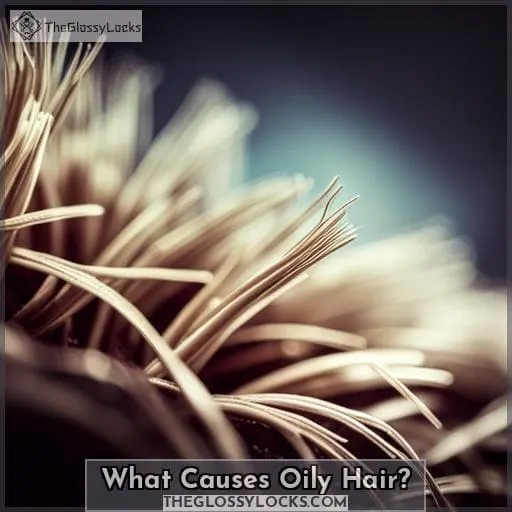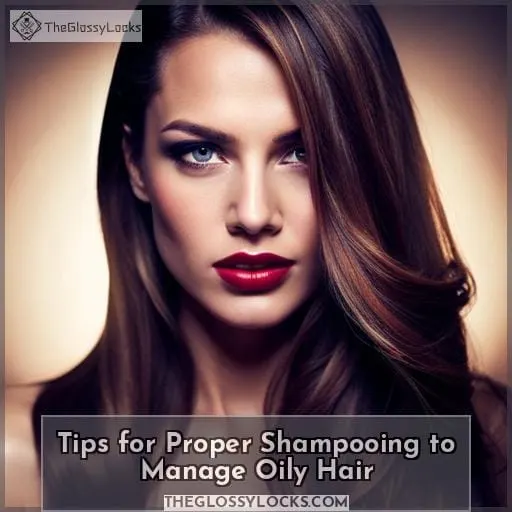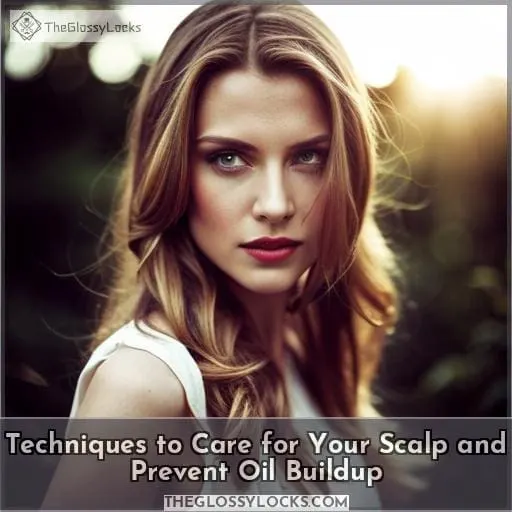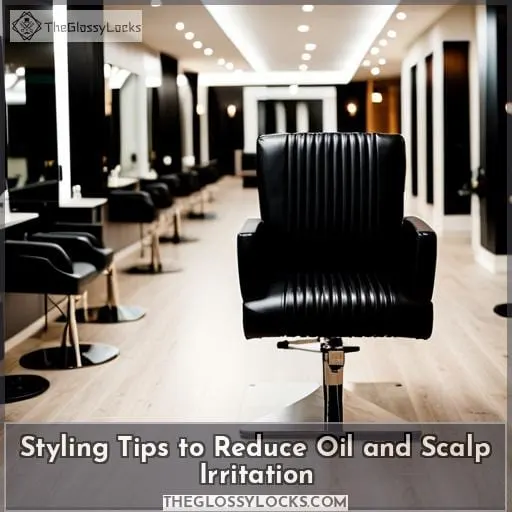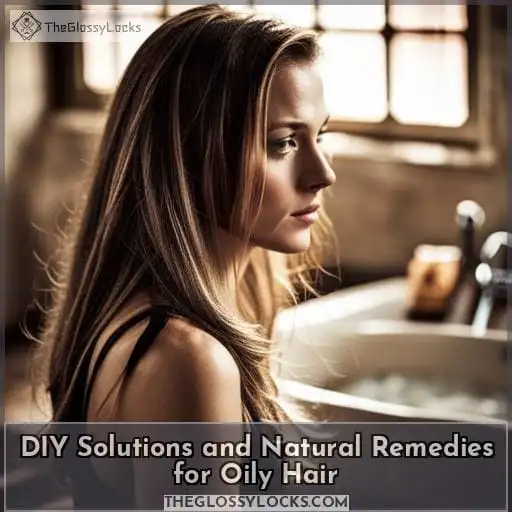This site is supported by our readers. We may earn a commission, at no cost to you, if you purchase through links.
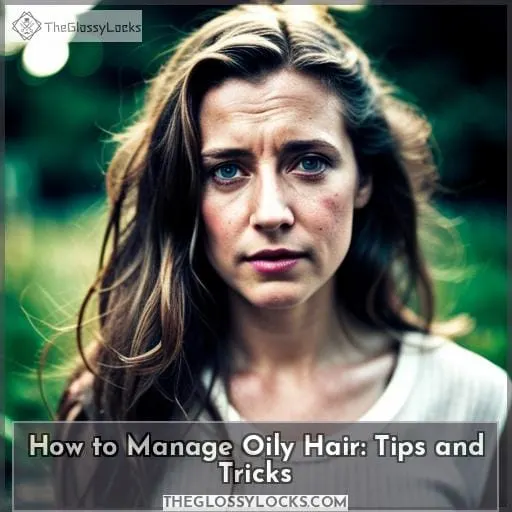
But fear not, because in the quest for the perfect, non-greasy locks, you’ve just stumbled upon your arsenal of liberation and mastery.
So, what’s the deal with oily hair, and how can you regain that sense of power over your mane? Oily hair is a result of your scalp’s sebaceous glands going into overdrive, producing more oil than you’d like.
This excess oil can make your hair look greasy and feel heavy, not to mention the potential itchiness and irritation it brings.
In this guide, you’ll learn how to determine if you have oily hair, the art of proper shampooing, scalp care techniques, and styling tricks to keep the oil at bay. We’ll also help you choose the right products and even know when it’s time to call in the professionals.
Get ready to conquer oily hair and unlock the secrets to luscious, balanced locks that scream power and confidence.
Table Of Contents
- Key Takeaways
- What Causes Oily Hair?
- Factors That Contribute to Excess Oil
- How to Determine if You Have Oily Hair
- Tips for Proper Shampooing to Manage Oily Hair
- Techniques to Care for Your Scalp and Prevent Oil Buildup
- Styling Tips to Reduce Oil and Scalp Irritation
- Choosing the Right Hair Products to Prevent Scalp Irritation and Buildup
- When to Consult a Dermatologist for Oily Hair Treatment
- Lifestyle Considerations to Manage Oily Hair
- DIY Solutions and Natural Remedies for Oily Hair
- Conclusion
Key Takeaways
- Use sulfate-free shampoos and mild conditioners, focusing the conditioner on the hair ends.
- Wash your hair frequently and thoroughly rinse out shampoos and conditioners.
- Avoid heavy oil treatments and use gentle styling techniques like air drying and wide-tooth combs.
- Manage oil production through scalp scrubs, clarifying shampoos, and consulting a dermatologist if problems persist.
What Causes Oily Hair?
Excess sebum on your scalp, often triggered by factors like changing hormones, genetics, humidity, and stress, is the root cause of that unwanted greasy look.
Your hair type plays a significant role; fine hair tends to get oily more quickly than coarse hair.
Hormonal factors, such as puberty or pregnancy, can intensify the problem.
Seasonal changes, like increased humidity, can also lead to oilier hair.
Your hair-washing habits matter too – washing too frequently or using harsh shampoos can prompt your sebaceous glands to produce even more oil in response to the scalp’s dryness.
Furthermore, external influences like using heavy, oil-based hair products or constant exposure to pollution can exacerbate the issue.
To master the management of oily hair, understanding the root causes is the first step. It allows you to make informed choices in your haircare routine and product selection, putting you on the path to liberating your locks from excess grease and enjoying fresh, vibrant hair.
Factors That Contribute to Excess Oil
Understanding why you have oily hair can help you manage it effectively. Hormonal changes and genetics play significant roles in excess oil production on your scalp.
Hormonal Changes
Hormonal changes, particularly during adolescence, can lead to a 70% increase in sebum production, leaving you frustrated with the constant battle to maintain your scalp’s balance.
To conquer this challenge, consider these haircare tips:
- Adjust your routine: Adapt your haircare routine to suit your changing hormonal patterns.
- Prioritize scalp health: Give your scalp gentle care and use suitable products.
- Debunk oily hair myths: Be aware of common misconceptions and seek accurate information.
- Explore DIY remedies: Check out homemade solutions to keep oiliness in check.
- Know your hair type: Tailor your approach based on your specific hair type.
Understanding the impact of hormonal changes on your hair is the first step toward mastering your oily hair concerns.
Genetics
If your family has a history of oily skin and hair, it’s likely that your genetics play a significant role in your scalp’s sebum production. Genetics can influence the size and activity of your sebaceous glands, which in turn affect how oily your hair gets.
Understanding your genetic predisposition to greasy hair is the first step in tailoring your hair care routine to combat excess oil effectively.
Genetics not only affect sebum production but also hair texture. Greasy hair might behave differently in straight or curly hair types. Understanding these genetic factors can help you choose the right shampoo, styling products, and hair care routines to manage oily hair effectively.
| Genetics and Oily Hair | Impact |
|---|---|
| Sebaceous Glands Size | Can determine how much sebum your scalp produces. |
| Sebaceous Glands Activity | Influences how quickly sebum is secreted. |
| Hair Texture | Genetics play a role in your hair type and how it interacts with oils. |
Humidity
In humid environments, your scalp’s sebaceous glands can go into overdrive, leaving you with a constant battle against greasy locks.
- Opt for hairstyles that work with humidity, such as braids or updos.
- Use a purifying shampoo to cleanse your scalp and remove excess oil.
- Apply a lightweight conditioner to your hair ends to prevent frizz.
- Incorporate a scalp toner into your routine to maintain balance.
These strategies will help you maintain control over your hair in humid conditions, ensuring a fresh and grease-free look.
Stress
Amidst the demands of a stress-filled life, you might find that your scalp’s sebaceous glands become more active, resulting in an unwanted greasy appearance. Managing stress is crucial; it can help regulate oil production. Consider lifestyle changes such as meditation, yoga, or exercise to reduce stress levels.
Additionally, dry shampoo can be your go-to when your hair needs a quick refresh.
How to Determine if You Have Oily Hair
Wondering if your scalp gets greasier than most? Here’s how to determine if you have oily hair:
- Look for shine and limpness. Oily hair usually appears extra glossy and feels heavier or more limp compared to other hair types.
- Check the roots after a day or two since your last wash. Noticeable oil buildup from the root to tip indicates excess sebum production by the scalp.
- Try the touch test. Rub strands between your fingers to detect any grease caused by overactive oil glands on the hair’s surface.
- Use the smell test. Unpleasant odors resulting from accumulated dirt and sweat may emanate from unwashed hair, a sign of overly oily strands.
Tips for Proper Shampooing to Manage Oily Hair
To effectively manage oily hair, it’s crucial to master the art of shampooing. This involves a three-pronged approach: washing more frequently, choosing the right shampoo, and ensuring a thorough rinse.
These simple yet effective steps will help you keep excess oil at bay and maintain fresh, healthy-looking locks.
Wash More Frequently
To effectively manage excess scalp oil, you should consider washing your hair more frequently, especially if you’ve noticed increased greasiness. Washing your hair every day or every other day can help control oil buildup. Use a sulfate-free shampoo designed for oily hair, and be gentle during the process.
Avoid over-brushing, as it can stimulate oil production. Additionally, using a tea tree shampoo can assist in reducing greasiness and dandruff, providing you with a fresher feel. If you want to enhance hair volume and reduce oil, consider opting for curly hairstyles; they can help mask the appearance of greasiness.
Furthermore, refrain from excessive touching or twirling of your hair throughout the day, as this can spread oils from your hands and make your hair look even oilier. These simple grooming techniques can go a long way in maintaining a fresher look.
Use the Right Shampoo
When battling excess oil on your scalp, selecting the right shampoo becomes a pivotal choice in your quest for fresher, more voluminous locks.
To get started, choose shampoos that are sulfate-free and suitable for all hair types to avoid over drying or irritating the scalp. Avoid products with silicone ingredients as they can make hair look greasy; opt instead for those containing green tea extract, which helps reduce sebum production while nourishing the skin.
It’s also best practice to select cleansing products specifically designed for oily hair solutions. Make sure to read labels carefully to ensure you’re avoiding unnecessary buildup from certain ingredients like waxes and oils.
With these helpful tips in mind when choosing shampoo, you’ll be on track to achieving healthy-looking tresses free of excess grease!
Rinse Thoroughly
Ensure you thoroughly rinse your hair after shampooing to eliminate any lingering product or residue that may contribute to excess oil. This step is crucial for preventing residue buildup, which can give the illusion of greasier hair.
Residue can also lead to scalp irritation, so take your time while rinsing to ensure that all shampoo is completely washed away. This simple yet essential action contributes to overall scalp health and dispels common myths about oily hair.
Techniques to Care for Your Scalp and Prevent Oil Buildup
To care for your scalp and prevent oil buildup, it’s essential to apply a mild conditioner, but here’s the key: focus on the ends of your hair, not the scalp. This straightforward technique can help strike the proper balance, keeping your hair nourished without over-oiling your roots.
Alternating shampooing with a gentle cleanser and conditioning the mid-lengths and ends is an easy way to maintain healthy hair and a clean scalp. Scale back on harsh shampoos, handle wet hair gently, and sleep on a clean pillowcase to support scalp health.
With some thoughtful adjustments to haircare routines, it’s simple to have soft, shiny locks without excess oil at the root.
Apply Mild Conditioner to Ends Only
You’ll add lightweight moisture without slipping if you apply a mild conditioner only to your ends, not near the scalp.
- Focus conditioner application on the mid-shaft to ends.
- Use a wide-tooth comb for even distribution.
- Rinse thoroughly to avoid residue.
- Look for lightweight, silicone-free formulas.
- Limit conditioner use to 1-2 times per week.
Targeting just the lower half of your strands with conditioner prevents weighing down your roots. This approach provides light conditioning to dry ends without excess oil transfer.
Avoid Overnight Oil Treatments
With great care, avoid leaving excess oil treatments on your precious scalp overnight.
| Pros | Cons |
|---|---|
| May provide extra moisture | Can lead to oiliness or irritation |
| Convenient to leave in overnight | Risk of contact dermatitis |
| Some oils have nourishing properties | Potential for buildup or dullness |
Instead, use lighter oils briefly before washing them out. Opt for scalp scrubs, green tea shampoos, or boar bristle brushes to invigorate your scalp without leaving residue.
Careful Towel-Drying and Brushing
Twist your freshly shampooed locks gently with the towel and apply a wide-tooth comb to prevent spreading oils from root to tip. When towel drying, be careful not to rub vigorously, as this can irritate the scalp and spread excess oils down the hair shaft.
Instead, blot hair gently to soak up moisture. Use a wide-tooth comb and brush your hair in sections slowly, starting at the ends and working up towards the roots. This will help distribute your natural oils evenly without spreading excess grease.
Styling Tips to Reduce Oil and Scalp Irritation
Managing oily hair can be frustrating, but styling techniques are available to help you reduce oil and scalp irritation. Be cautious when using heat tools like straightening irons and blow dryers, as overuse can worsen oiliness and damage your scalp.
Instead, try to let your hair air dry as often as possible. Consider using dry shampoo between washes to absorb excess oils. Use volumizing mousse when blowdrying to lift roots and create texture, avoiding direct heat on the scalp which can increase oil production.
When heat styling, use a heat protectant and opt for styles that don’t lay flat on the scalp. Tie hair up when possible and use accessories like headbands to keep hair off the face and scalp. Clarify regularly to remove product buildup that can trap oils and irritate skin.
With some adjustments, you can reduce oiliness and irritation while still enjoying stylish looks.
Heat Styling With Caution
Let heat styling help reduce greasiness, but treat your scalp gently to prevent irritation. Use dryers and irons in moderation to avoid excessive heat damage. Prep hair with a heat protectant first for added defense against dryness.
Alternate heat tools with gentle natural remedies. An aloe treatment can soothe and an apple cider vinegar rinse balances pH. When possible, air drying or using boar bristle brushes to distribute oils naturally is best.
With some thoughtful care, you can safely leverage heat while keeping your scalp happy.
Avoid Scratching or Picking at the Scalp
Scrub your scalp gently when shampooing so you don’t irritate it.
Avoid excessively brushing, combing, or scratching your scalp. This can irritate it and increase oil production.
Be gentle when towel drying your hair. Rough handling can provoke irritation.
Tie your hair back loosely to avoid pulling on the scalp. Tight styles can cause irritation over time.
Opt for wide-tooth combs and natural bristle brushes. These are kinder to the scalp than plastic bristles.
If the itching persists, see your dermatologist. They can evaluate if you have a skin condition causing the symptoms.
Choosing the Right Hair Products to Prevent Scalp Irritation and Buildup
When dealing with oily hair, it’s important to choose the right hair products to prevent scalp irritation and buildup. To start, opt for sulfate-free shampoos to avoid overwashing. Incorporating scalp scrubs into your routine can lift oil and reduce buildup as well.
Choosing sulfate-free shampoos
When choosing shampoos, you’d be wise to avoid those containing sulfates, which can strip hair’s natural moisture and aggravate sensitive skin.
| Shampoo | Key Benefits |
|---|---|
| Shea Moisture Coconut & Hibiscus | Hydrating, targets dandruff |
| DevaCurl Low-Poo Original | Curl-friendly, non-drying |
| Ouidad Curl Quencher | Defines curls, moisturizes |
| Pureology Hydrate Shampoo | Color-safe, nourishing |
| Kristin Ess The One Signature Shampoo | Balances moisture, affordable |
Sulfate-free shampoos cleanse hair without over-drying, making them an ideal choice for those with oily yet sensitive scalps.
Incorporating scalp scrubs
Your scalp longs for the revitalizing caress of a sugar scrub to gently lift grease and debris, as Ulysses yearned for home. DIY scrubs using natural ingredients like sea salt, lemon juice, and olive oil deliver the needed exfoliation for oily hair and scalp health.
With simple recipes, you can take control over buildup. Customizable scrubs provide solutions, revitalizing your scalp and strands. You can liberate locks from excess oils through gentle, frequent exfoliation. It is possible to gain mastery over greasy hair.
Avoiding silicone ingredients
Instead, choose shampoos without silicone, which can weigh hair down. Opt for natural, sulfate-free formulas using cleansing agents like saponified oils. These remove buildup without stripping oils or leaving behind silicone residue. Making informed choices prevents myths about oily hair from dictating your haircare.
When to Consult a Dermatologist for Oily Hair Treatment
If excess oil persists despite home care, you’ll wanna see a dermatologist for help. A dermatologist can provide a professional evaluation to determine the underlying cause of your oily hair. They may recommend medical treatments like prescription shampoos containing ketoconazole to reduce oil production.
A dermatologist can also analyze your scalp and hair to look for conditions like seborrheic dermatitis that may be contributing to excess oil. With their expert advice, you can find an effective oily hair treatment plan that addresses the root causes.
Getting medical assistance for ongoing greasy hair struggles can help provide solutions when at-home methods just aren’t cutting it. A dermatologist consultation may be the key to getting your oily hair under control.
Lifestyle Considerations to Manage Oily Hair
Here are some lifestyle considerations to help you manage oily hair. Be mindful of activities that cause sweating or spread oils, potentially making your hair look less fresh. Also, avoid hats, helmets, or headbands that may trap heat against your scalp and spread oils.
Avoid Excessive Heat Styling
Let your hair air-dry to minimize heat damage. While blow drying or flat ironing may temporarily tame oils, excessive heat styling can worsen oil production and irritate the scalp long-term. Embrace your hair’s natural texture and volume by letting it dry undisturbed after washing.
Air drying prevents damage from high heat, helping hair stay healthy while reducing scalp oiliness.
Be Mindful of Sweating
- Wear a headband when exercising to absorb sweat.
- Use dry shampoo after activities that cause sweating. This can help absorb excess oils.
- Pull your hair up to minimize contact between your hair and sweat. A ponytail or bun works well for this.
- Shampoo soon after sweating to remove excess oils and sweat from your hair. Don’t let it sit there.
- Avoid wearing hats or helmets that can trap sweat and oils against your scalp.
The key is to proactively manage sweat so it doesn’t spread oils and make your hair limp. With some simple adjustments to your routine, you can maintain great looking hair despite an active lifestyle.
Avoid Hats, Helmets, and Headbands
You’ll trap heat and spread oils wearing hats, helmets, and headbands. When styling oily hair, be selective with accessories. Tight-fitting items prevent heat from escaping, exacerbating an oily scalp. Trapped sweat spreads excess oils, forcing you to shampoo more often.
Stick to loose, breathable fabrics when possible to allow airflow. This precaution helps you avoid aggravating your oily roots and making hair appear limp.
DIY Solutions and Natural Remedies for Oily Hair
Over 50% of women struggle with excess sebum production, so try a scalp scrub with sea salt, lemon juice, and olive oil to lift oil and promote a clean scalp.
Natural remedies like apple cider vinegar rinses help restore your scalp’s pH balance, while aloe vera masks hydrate without leaving residue.
For a simple DIY dry shampoo, use cornstarch or arrowroot powder to soak up excess oils.
Coconut oil treatments and gentle scalp massages with essential oils such as tea tree, rosemary, or peppermint can also provide soothing relief.
Herbal options like witch hazel reduce inflammation.
Overall, organic approaches that incorporate natural ingredients into your hair care routine without stripping your scalp are great for dealing with oily hair and promoting hair health.
Conclusion
The theory that oily hair is purely genetic has proven untrue. While hormones and genetics play a role, you also have the power to manage excess oil through proper shampooing, scalp care, and smart styling.
Implementing techniques like washing thoroughly with the right shampoo, gently scrubbing your scalp, and carefully heat-styling will help you take control of oily hair. With some trial and error, you’ll find the perfect routine to reduce grease and keep your hair fresh.

